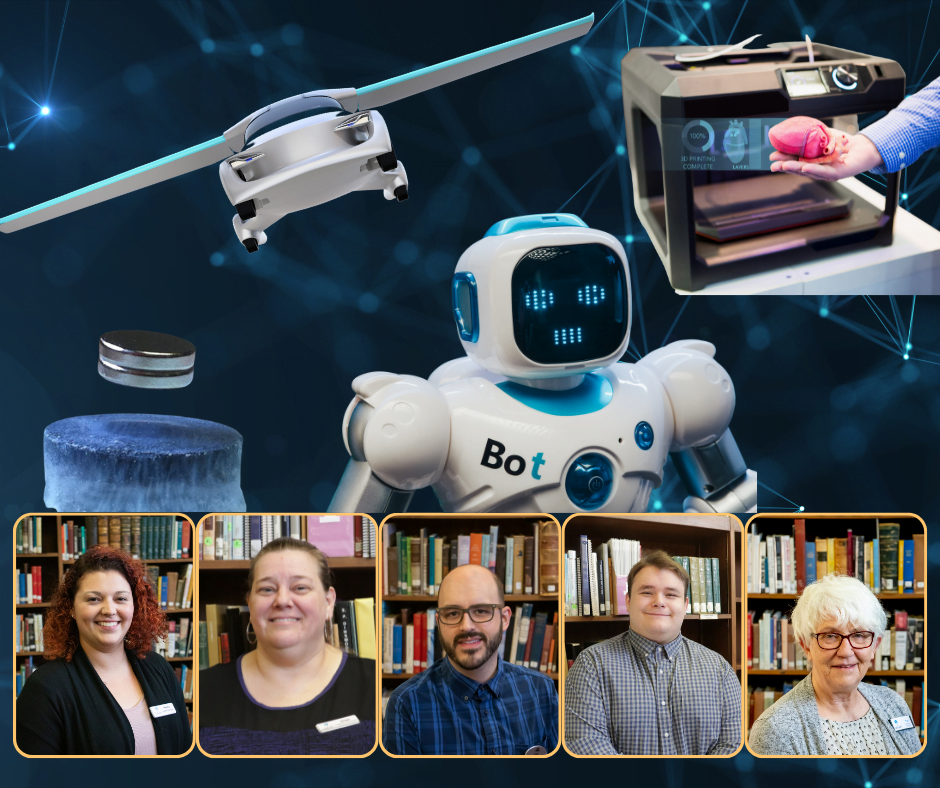
Space exploration, construction, health concerns, clean water, sustainable agriculture, what do all of these topics and many more have in common? Innovative tech solutions! Technological advancements constantly change the way we perceive and live our lives, beyond communication and entertainment. The Salina Public Library tech team would like to share some of our research and thoughts on current, progressive, beneficial technology.
More Than Just Your Basic Computer
By Hanna S.
If you are not an IT professional or hobbyist you probably don’t realize that there are more computers out there than just your average laptop or desktop. There are actually two other kinds of computers that are able to solve harder problems quickly and correctly. The next step above our average computer is a supercomputer. This system works similarly to a basic computer but has more than one CPU (which acts like a brain). Due to having more “brain power” it can focus on a single problem and determine a solution much faster than our wimpy, single-CPU technology. With the advancements of the supercomputer, we have seen enhancements to machine learning and in turn AI (artificial intelligence)! Jumping one step further than the supercomputer is a quantum computer. These systems are able to bring multiple solutions to multiple variable problems that can be unpredictable! One way this system is used is for hands-free driving. These systems have very different hardware than that of our typical computers and supercomputers. In fact, most of the hardware is to just cool the “brain” of the computer.
3D Printing: Prosthetics
By Kristi S.
Can you believe that 3D printing has been around since the 1980s? 3D printing has become more popular and more affordable as the years have gone by. I think that with 3D Printing, the technology is moving in the right direction. It assists people in all different areas. This includes helping children, adults, and animals with affordable prosthetics. Prosthetics are artificial body parts that are created to take the place of an absent body part (leg, arm, hand, etc). The process in which traditional prosthetics go through is time-consuming and expensive to make. They are created from a mold type that does not fit all types of people. This makes them very uncomfortable and less functional. According to GlobeNewswire, traditional prosthetics range from $1,500 to $8,000, but a 3D-printed one can run as low as $50. The process in which they create the traditional prosthetic goes through many steps and different companies, which causes the price to go up. 3D prosthetics have become a more affordable way for people and animals. Not only does it take less time to create a 3D printing, but it also allows for the person receiving the prosthetic to have measurements that fit exactly what they need. This will give them a prosthetic that fits better and is more flexible with their movement. If you are interested in learning more about 3D-printed prosthetics and check out this link: https://www.ntop.com/resources/blog/3d-printing-in-prosthetics-a-design-guide/
AI: Importance of Open Access
By Sam S.
AI technology is booming. Ever since Dall E, Stable Diffusion, and ChatGPT have been released, a multitude of AI Products have come to market. There is a worry in this technology boom though, and that is access. Right now the barrier to accessing AI technology is low, but as companies continue to investigate ways to profit from these new technologies that might quickly change. AI allows automation to work in ways that were previously hard, if not impossible, to automate, and will provide incredible advantages to individuals with access to this evolving technology. Therefore open and equal access to this technology is important to prevent creating a subclass of individuals unable to access and benefit from AI technology, thus being unable to advance in a career or education at the same rate as someone with AI access. I have compiled a short list of open AI technologies that are capable to run on local consumer hardware, these are not the best or as capable as the leading products, but some examples of what is currently available free and open to the public:
- Automatic1111: Locally-hostable Open web interface for running Stable Diffusion.
- Tabby: Locally-hostable Open alternative to GitHub CoPilot programming assistant.
- StableLM: Locally-hostable Open and free alternative to ChatGPT.
Flying Cars?
By Duncan A.
“Roads? Where we’re going, we don’t need roads”. This quote by Doc Brown sparked the imagination of many people of what it would be like to one day have a flying car. While many personal flying vehicles are in development, none have looked like a car, because cars were not designed to fly. Plane design forces air moving over the wing to go faster. The faster air causes pressure under the wing of the plane to be higher, producing lift and allowing forward flight through thrust. Cars can move forward by creating thrust through friction between the rotating tires and the ground. While car design has become more aerodynamic over the years, it simply cannot produce the force needed to move in a forward direction without ground friction. However, a new design by Alef Aeronautics is tipping things in a new direction! While on the ground, the Alef Model A looks and drives like a car. The Model A uses propellers underneath the chassis to lift itself from the ground. Once airborne, the Model A turns 90 degrees in the air, changing the sidewalls into wings. The Model A effectively becomes a Biplane with the propellers creating thrust for forward flight. While we are still far from seeing DeLoreans flying through our neighborhoods, the Alef Model A is an exciting step in the right direction and an exciting window into the future!
Super, Duper Superconductors!
By Pat B.
I have chosen to discuss a subject in electronics that has always fascinated me, the superconductor. So, what is a superconductor? A superconductor is a material that conducts electricity with no resistance and doesn’t allow magnetic fields to penetrate. What this means is that the current can continue to flow indefinitely with no energy loss. Sounds great, right? Well, back in the 1990s, when I first became interested in superconductors, researchers were mostly working with ceramic materials and they would only conduct at temperatures around -270 or so degrees Fahrenheit. That doesn’t sound quite so great, however, recently things have changed. Scientists have now found a material that conducts electricity with no resistance at around room temperature, 72 degrees Fahrenheit. Breaking the room temperature barrier is amazing, yet, we have another obstacle, this material only conducts when it is greatly compressed. So, the next big step is to overcome the compression problem. How will that affect technology you ask? It will revolutionize energy production, electronics, medical equipment, and maglev transportation. It will be a game changer for everything from communication and AI to MRI machines, 3D printers, quantum computers and yes, even flying cars! I don’t know about you, but I can’t wait to see the next big tech breakthrough!

About The Author: Hanna
More posts by Hanna